Capital Campaigns 101: Ultimate Guide for Beginners [2025]
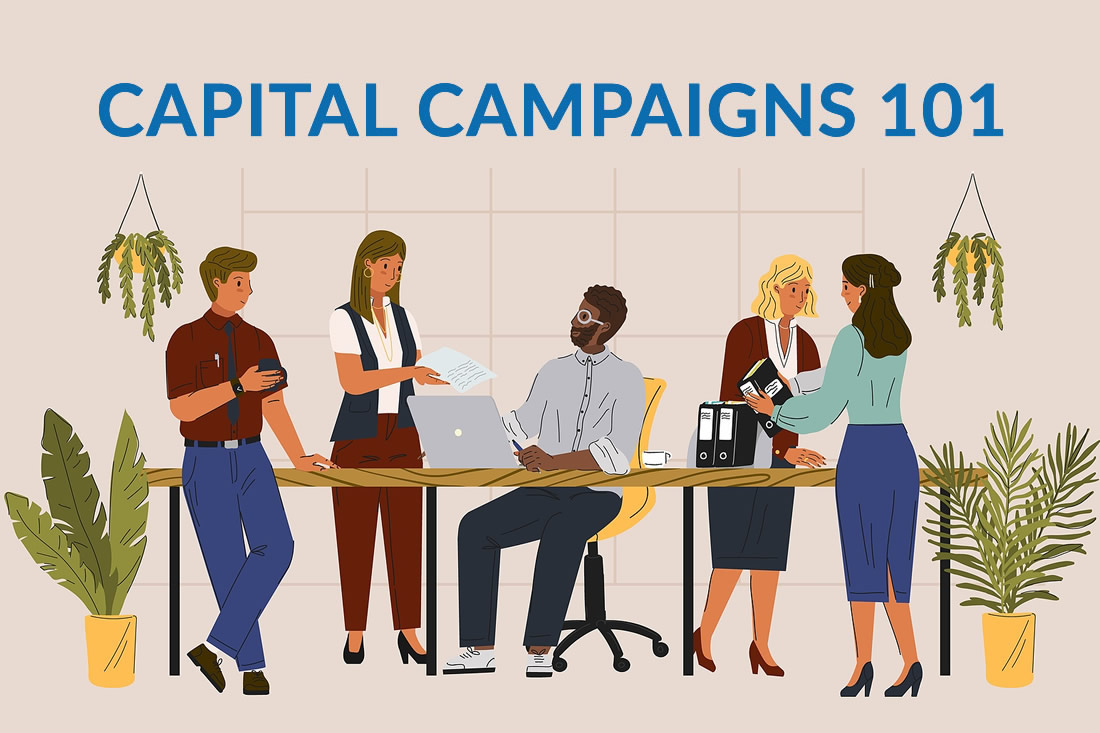
Is a capital campaign in your organization’s future? Perhaps you’ve heard one discussed by your board or have seen other nonprofits launch and complete impressive campaigns in your community. Whether you’re already excited to start planning your own capital campaign or just learning the ropes, we’ve got you covered.
Here you will learn everything you need to know about nonprofit capital campaigns. This guide has been updated for 2025.
Free Download: The State of Capital Campaigns
This groundbreaking research into how capital campaigns are planned and executed by North American nonprofits sheds light on many of the common questions and myths surrounding campaigns, including what the typical campaign giving pyramid looks like.
What is a capital campaign?
Let’s start with a quick definition:
Capital campaigns are intense fundraising efforts designed to raise a specific amount of money within a defined time period to build an organization’s assets and capacity. They typically raise much more than an organization has ever raised in a single campaign.
You can use a capital campaign to renovate or build new facilities, fund special projects requiring capital investment, build capacity, and increase an endowment. Campaigns invite donors to make special gifts over and above the recurring, annual operating gifts they make to an organization. Most nonprofits conduct a capital campaign every 10 to 15 years.
Let’s take a closer look — here’s what we’ll cover:
- The Basics of Capital Campaign Fundraising
- A Capital Campaign Timeline
- What You Need to Run a Capital Campaign
- How to Plan a Capital Campaign
- Hiring a Capital Campaign Consultant
- 3 Capital Campaign Examples to Inspire Your Team
- Fundraising in Uncertain Times
- Capital Campaign Knowledge Directory
- Download this Complete Guide as a PDF
Who are we? Capital Campaign Pro is support system for nonprofit leaders and their teams. Part expert consultant, part resource library, Capital Campaign Pro provides the expertise, resources, and confidence necessary to complete a successful campaign. Learn more about us here.

The Basics of Capital Campaign Fundraising
A quick note on our philosophy: Nonprofits have been conducting capital campaigns for a long time. There are tons of best practices and traditional strategies that you can rely on as you plan your own campaign. But don’t be afraid to get modern. We always recommend that nonprofits take a flexible campaign approach that adapts to their unique needs and goals while still rooted in sound capital campaign principles.

Capital Campaign FAQs
What do capital campaigns accomplish?
Successful capital campaigns move an organization to the next level of operation. They raise funds for specific investments that will increase the organization’s capacity and ability to pursue its mission. These investments could include some or all of the following assets:
- New buildings or renovations
- New or upgraded equipment
- Start-up funds for new programs
- Funds for increased staffing
- Endowment funding
How much money do capital campaigns raise?
A capital campaign’s goal depends on its objectives — the key investments and changes that it will enable. This means many different things to different nonprofits depending on their current priorities and capacities.
A small survey of nonprofits conducting campaigns by GivingMatters.com found a wide distribution of goals between $25,000 or less to $50 million or more. The majority of campaigns fell into the ranges of $100,000 to $999,999 and $2 million to $9.99 million. This diversity of goals highlights the flexibility of capital campaign fundraising for nonprofits of all sizes.
Whether you’re raising several thousand or many millions of dollars, it will almost certainly be more than your organization has ever raised before, and it will fund improvements that will take your nonprofit to the next level of growth.
What are capital campaigns not well suited for?
Capital campaigns are not intended to raise unrestricted money to support long-term operations. And while we have included endowment in the list above, it should be included as a secondary item in a capital campaign. Endowment funds are better raised through planned giving than through capital campaigns. There are also several red flags that can indicate you’re not yet ready for a capital campaign.
Download this Complete Guide as a PDF
Download a PDF copy of this guide to have on hand whenever you need it.
Can small nonprofits conduct capital campaigns?
Small nonprofits can and do run successful capital campaigns that follow the same principles as campaigns for larger organizations. The goals will probably be smaller, but the power of the campaign model can work just as well whether your organization has an operating budget of $500,000 or $5,000,000.
Will a capital campaign reduce our annual fundraising results?
If you plan your campaign correctly, it will not cannibalize your annual fundraising. In fact, most organizations find that their annual funds increase during the campaign period! This is because you’ll be in closer touch with your major donors and your relationships with them will grow. If they support your capital campaign, they are likely to want to continue to support your operations generously over the long run.
How much does it cost to conduct a capital campaign?
It may seem counterintuitive at first, but capital campaigns are the most cost-effective way of raising money! The budget for a typical campaign will likely be under 10% of its goal. And in addition to being cost-effective, your campaign expenses can be included in your fundraising goal and thus will not come out of your organization’s operating budget.
While all big projects bring some inherent risks, capital campaigns are not uncharted territory. Understand your organization’s risk tolerance and thoroughly plan ahead, but also be ready to adjust course if you encounter cost increases or donation shortfalls later in the campaign.
Want more answers to common questions about capital campaigns and our services? We’ve compiled a complete FAQ guide.

The 9 Key Principles of Capital Campaigns
Capital campaigns work differently than typical fundraising campaigns that you conduct each year. The capital campaign model has nine key principles that your team will need to understand:
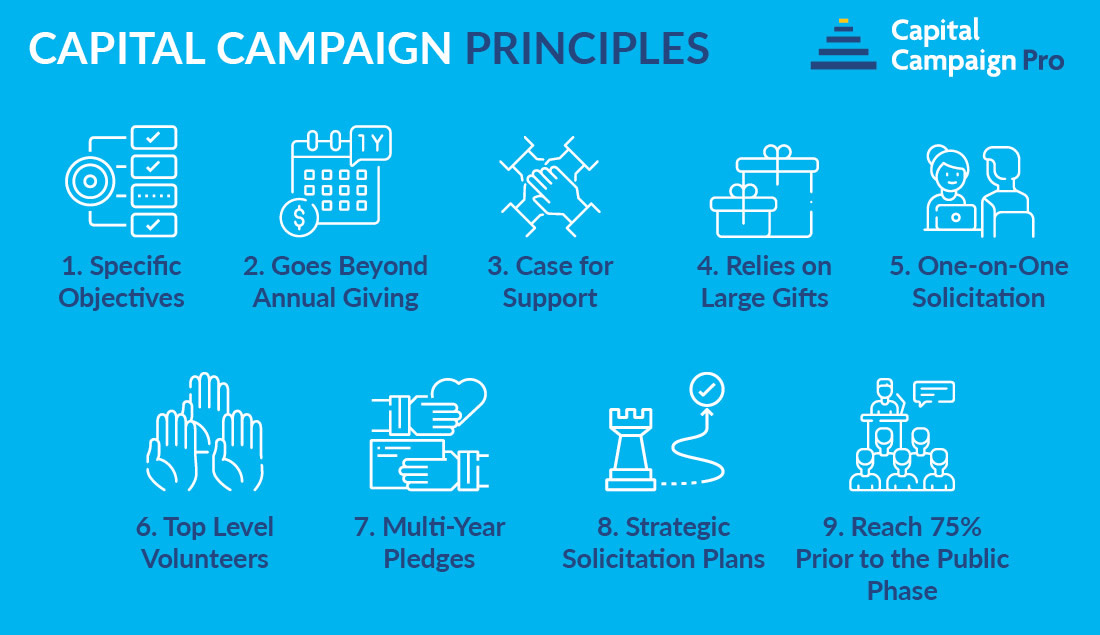
- Capital campaigns raise money for specific objectives. Unlike annual fundraising, these campaigns target specific objectives and shorter-term special investments that will increase your organization’s capacity.
- They ask for gifts that are over and above ongoing annual gifts. Since capital campaigns raise money for items that are not part of the operating budget, donations made to them are in addition to those that are given to support operations.
- Capital campaigns require a compelling case for support. Why donate to your capital campaign? Your case for support must be exciting and inspiring while explaining how its success will benefit your constituents and community.
- They rely heavily on large gifts. In a capital campaign, at least half of the total goal is raised from around ten large gifts. For most of the campaign, the primary focus is on your organization’s top 20-30 donors who are likely to give large donations.
- They’re built on one-on-one, personalized solicitation. Since capital campaigns rely on a handful of large gifts, you must solicit them in highly personalized ways. Building close relationships with prospective donors is a must.
- Capital campaigns engage top-level volunteers. Senior volunteers should play integral roles in planning and implementing a capital campaign. Some of the top-level volunteers (like the campaign chair or board chair) often solicit the largest gifts.
- They encourage donors to make pledged gifts. It’s normal to offer donors the option to pay their large campaign gifts over a period of three or more years as the campaign’s investments are purchased or built over time.
- They follow a strategic order of solicitation. You’ll start by soliciting the largest potential donors and those closest to the organization before broadening your attention to other donors. Securing the largest gifts first allows you to clarify and finalize your goal.
- Capital campaigns raise at least 75% of their goals before going public. You won’t publicly announce your campaign and its goal until more than 75% of its working goal has been secured. This allows you to adjust your plans as needed and ensures success.

A Capital Campaign Timeline: Understanding the Structure
Capital campaigns generally take between 2 and 3 years from start to finish. For large, complex institutions like universities, they can take much longer. A standard capital campaign will flow over the course of seven phases, which you can see in the campaign timeline graphic below:
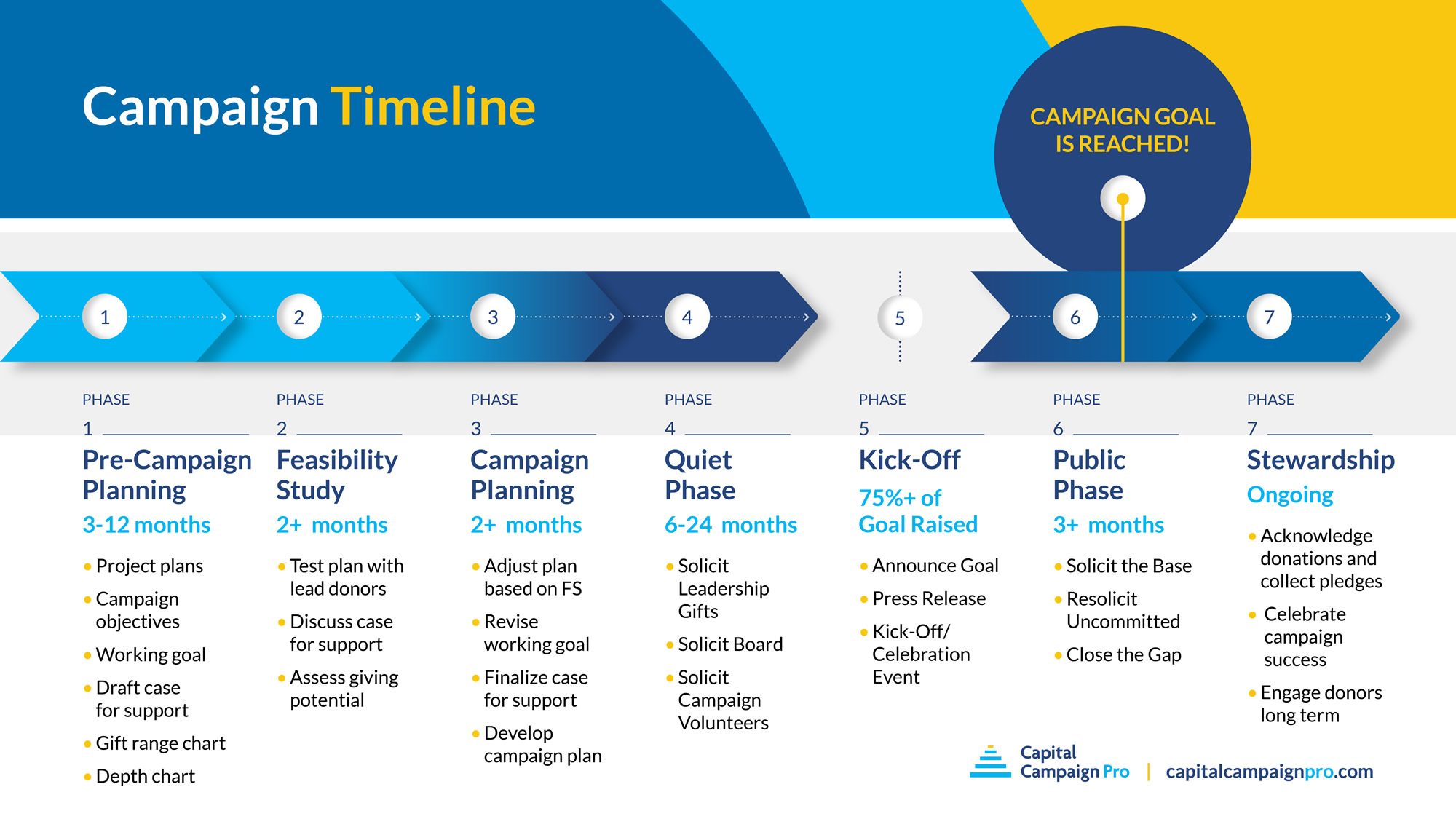
Phase 1: Pre-Campaign Planning
During this phase of the capital campaign, you’ll determine its objectives and settle on the preliminary dollar goal needed to reach those objectives.
Phase 2: Feasibility Study
During the feasibility study, you will test the plans you developed in phase one. Some organizations engage a consultant to interview their top donors to assess their willingness to support a campaign and then develop recommendations about the potential of the campaign.
At Capital Campaign Pro, we recommend a different process. We prefer to guide the organization’s leaders to conduct their own donor interviews, and then we help develop recommendations based on that process. This is a more cost-effective approach that further builds the relationship between the organization and its top donors.
Phase 3: Campaign Planning
After the feasibility study is complete and the board approves a capital campaign, you will assemble a campaign planning committee to review and finalize a complete plan. The campaign plan includes items like a campaign budget, timetable, policies, donor recognition plan, and a communications strategy.
Phase 4: Quiet Phase
During this phase of the campaign, you will solicit the largest gifts to the campaign, as well as gifts from board members and other key stakeholders. This phase of the campaign is conducted without publicity or fanfare. Organizations should raise at least 75% of the campaign goal during this phase of the campaign. Learn more about this critical phase with our tips for the campaign quiet phase.
Phase 5: Kick-off
By this point, you will have solicited most if not all of the largest gifts and every one of your board members. The actual results of those solicitations will give you a realistic assessment of what your final campaign goal should be. You may adjust the goal from the initial number either up or down, but you’ll now know precisely how much money you’ll be able to raise. That’s the goal you will announce at your campaign’s public kick-off. The kick-off of your campaign is a celebration, an opportunity to recognize campaign leaders and donors, and a press event all rolled into one.
Phase 6: Public Phase
The public phase of your campaign is short, intense, and full of energy. This is the time when you spread your campaign message as widely as possible and invite everyone in your extended community to give. By the end of the public phase, you should reach or exceed your campaign goal.
Phase 7: Post-Campaign
While you may imagine that the campaign is over once you reach your fundraising goal, that’s far from the case. You will have many loose ends to tie down, donors and volunteers to thank, reports to prepare, and pledges to bring in. The long-term success of your campaign depends on how well you complete this final follow-through!

What You Need to Run a Capital Campaign
Capital campaigns are not the right fundraising approach for every organization at any given time, but if you can check off all six items below, then starting a capital campaign may be the right choice:
→ A high-functioning board
A fully committed board that actively fundraises is critical to the success of your campaign. Do all of your board members currently make meaningful contributions? If your board members aren’t committed enough to make personally meaningful annual contributions to your organization, chances are good they won’t be committed enough for a major campaign.
In these cases, improving board engagement would be essential prior to committing to a campaign. Many nonprofits also choose to reorganize or expand their boards with more engaged members in preparation for major campaigns. Early in the campaign planning period is a good time to encourage uncommitted board members to step off the board, leaving room for new people.
→ Effective and willing volunteer leadership
Can you identify influential leaders in your community who might be willing to serve in a leadership capacity for your campaign? The right people chairing your capital campaign can make your success just about inevitable. Start identifying and recruiting a strong leadership team very early in your campaign planning process.
→ Involved leadership-level donors
If you can identify a donor who is likely to make a gift of 20% or more of your campaign goal and at least 20 other donors who have the ability and inclination to make a large gift, you are on track for a successful campaign.
→ A well-organized development office
Your development office will have to be equipped to handle a capital campaign. You’ll need experienced development staff and effective systems before you begin your campaign. Make sure that you budget adequately for the additional staff you will need for your campaign, as well.
→ A clear plan and a compelling case
Every capital campaign is based on a clear and specific set of campaign objectives that outline what you will raise the money for. Those objectives must then become the basis for a clear and compelling case for support that will convince donors to give.
→ A positive image in the community
Your organization does not need to be extremely prominent, but you do need a strong positive reputation in the community you serve. Are you seen as a leader in your service area? Do people in your community have confidence in your work? Your campaign will build on the sense of trust you have created in your community.

How to Plan a Capital Campaign
Capital campaigns are big, complex endeavors, and a good plan is critical to keeping you and your team on track. The planning process should also be intentionally used to engage potential donors, committee members, and volunteers who will help make the campaign a success. Preparing for your campaign is divided into 2 parts — Pre-planning and Creating the Plan:
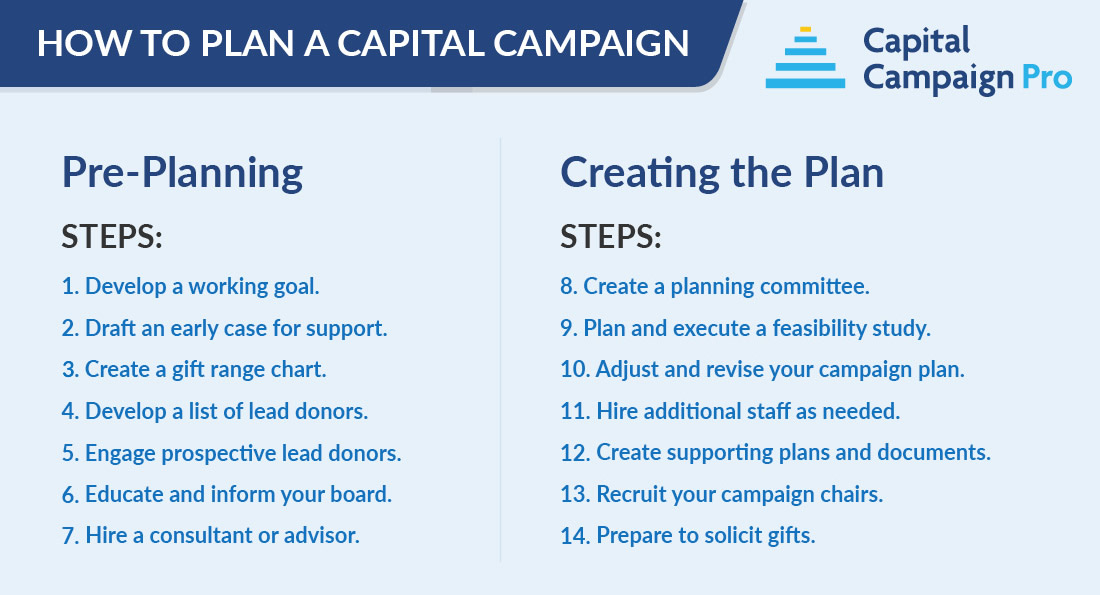
Part 1: Pre-Planning — Laying the Foundation for Your Campaign
- Develop a working goal that includes all of the expenses/costs related to your campaign.
- Draft an early case for support.
- Create a gift range chart that reflects the number of gifts you need at each giving level.
- Develop a list of potential lead donors and supporters, including board members.
- Engage prospective lead donors in visioning conversations to secure their buy-in.
- Educate and inform your board members about their roles in the campaign, its plans, and the overall strategy.
- Hire a capital campaign consultant or campaign advisor.
Part 2: Creating the Plan — Building the Framework for Your Campaign
- Form a campaign planning committee (learn more about campaign committees here).
- Plan and conduct a feasibility study to test your campaign’s working plans and goal.
- Adjust and revise your campaign plan based on the study’s feedback.
- Hire additional staff to assist with your campaign as needed.
- Create a budget, timeline, campaign policies, communication strategy, and a donor recognition plan.
- Recruit your campaign chairs.
- Prepare to have conversations with lead prospects and eventually solicit gifts.
Want a deep dive into all of the steps listed above? Review our complete guide to capital campaign planning.
Extra Capital Campaign Ideas to Boost Your Results
Once you’ve outlined the core plan and timeline for your campaign, think about incorporating extra ways to boost your revenue and donor engagement.
You’ll have plenty of flexibility as your campaign progresses to build in new outreach strategies and public phase promotional tactics, but some ideas need upfront coordination. Consider these examples:
- Special events. Walkathons, auctions, large galas, and lavish groundbreakings will require extra planning. Sketch out your initial event strategy and timeline, then plan ahead to devote time to organizing your events several months ahead.
- Matching challenges. Challenges in which a sponsor or major donor will match donations received within a certain timeframe need to be agreed upon beforehand.
- Sponsor arrangements. Other sponsorship agreements, like event support and commercial co-ventures, will also need to be worked out in advance.
- Additional giving initiatives. Depending on the scope of the campaigns, some nonprofits choose to launch extra initiatives to boost their planned giving programs or endowments. If there are other giving programs you’d like to promote, think through how you’ll do it while keeping the main emphasis on the campaign itself.
- Ambassador campaigns. Recruiting high-profile donors to serve as ambassadors, host small gatherings, and help promote the campaign can be a winning strategy in both the quiet and public phases. You’ll need an initial plan and recruiting timeline.
If you choose to incorporate any of these or other ideas into your campaign to boost visibility and revenue, you may need to get started laying out your plans soon (as with official sponsorship agreements). For less complex strategies, you can designate a future date in the campaign to begin planning them.
Either way, giving your team a heads-up will be key so that the process will stay organized and as effective as possible.

Hiring a Capital Campaign Consultant: Everything You Need to Know
Because most organizations only conduct a capital campaign every 10 or 20 years, very few fundraising professionals and board members have deep experience organizing them. And because the amount of money to be raised is usually quite high, the investment in professional help can be worthwhile. Good capital campaign consultants should have deep experience in the field and be able to lead the charge in these roles:
- Development assessments
- Feasibility studies
- Campaign planning
- Campaign materials
- Solicitation training
- Board training
- Post-campaign assessments and reports
Traditional consultants often work with an organization throughout the campaign, unveiling the work to be done phase by phase. Some consulting firms actually embed a staff member in the development office for several months of the campaign to serve as a campaign manager. Most consultants, however, don’t directly manage the campaign but instead provide guidance as required to move the campaign forward.
Learn how to hire a consultant and the key qualities to look for in our deep dive into capital campaign consulting.

Capital Campaign Pro’s Philosophy
Capital Campaign Pro uses a different approach — one made possible by the accessibility of online and virtual communication. Through our Capital Campaign Pro toolkit, organizations gain immediate access to all of the tools and materials they will need for their campaign organized in a clear step-by-step process. They are given the option of working virtually with a very experienced campaign advisor (in a group or individually), to help them move through the campaign process.
This approach enables staff and board members to develop their skills and be more actively involved in designing and implementing the campaign than they would with a traditional consultant. It works well for nonprofits of all sizes:
- For organizations with capable development staff and eager board members, this approach is more effective and affordable.
- For growing nonprofits with little development experience, this approach allows your team to actually learn along the way rather than passively receive instructions piece by piece.
We believe in expanding access to capital campaign support regardless of a nonprofit’s consulting budget. Our modern approach gives you all the resources you need in their entirety and encourages staff to become active partners in the campaign process.
Your development staff and campaign leaders won’t feel isolated in a high-stress situation but rather part of a peer-learning community of other nonprofits conducting capital campaigns. Not to mention, virtual advising keeps things streamlined, efficient, and much less costly than traditional, in-person consulting!
Explore our approach and campaign advising services. We’d love to hear about your vision for your nonprofit’s growth.


3 Capital Campaign Examples to Inspire Your Team
As your nonprofit considers or prepares for a capital campaign, you’ll find it useful to study up on some examples of capital campaigns. These success stories can show you what is possible with careful planning and preparation and the right guidance. Here are just a few of our favorites:
#1 – Historical Society Capital Campaign Example – Montauk Historical Society
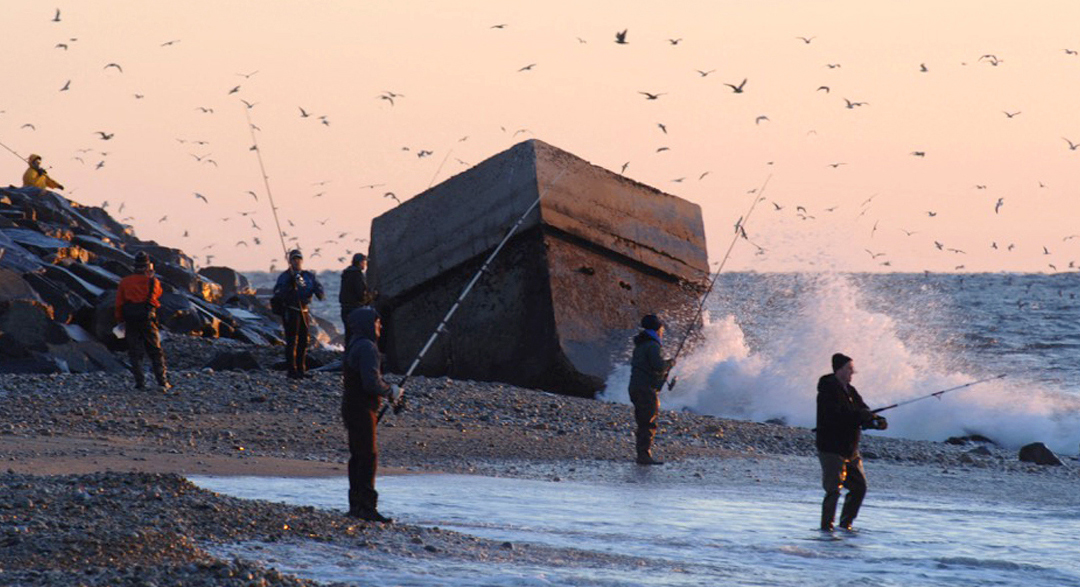
The Montauk Historical Society (MHS) aims to collect, restore, preserve, and display the history and culture of Montauk, New York. In 2016, the organization learned from a building assessment that the beloved Montauk Point Lighthouse needed an extensive exterior restoration that was going to cost $1.3MM.
MHS turned to Capital Campaign Pro for help. Using our team’s online resources, advisor support, and weekly group calls, MHS exceeded its funding goal, raising $1.8MM dollars. This allowed them to renovate a second building as well as the lighthouse.
Now, backed by the momentum of this successful campaign, MHS is on its way to conducting an even larger campaign, establishing an annual fund, and building out a sustaining members program.
#2 – Technical College Capital Campaign Example – Lakeshore Technical College

Based in Cleveland, Wisconsin, Lakeshore Technical College (LTC) offers over 100 career programs and serves more than 13,000 students each year. In 2023, LTC broke ground on a new Center for Health Care Excellence, which will benefit 1,500 health care and emergency services students on campus.
However, in order to secure state funding for the center, the LTC Foundation needed to raise $3MM in private donations. They reached out to Capital Campaign Pro for support.
Thanks to a guided feasibility study and the resulting insights and strengthened donor relationships, LTC was able to quickly meet its goal.
#3 – Animal Shelter Capital Campaign Example – Tabby’s Place
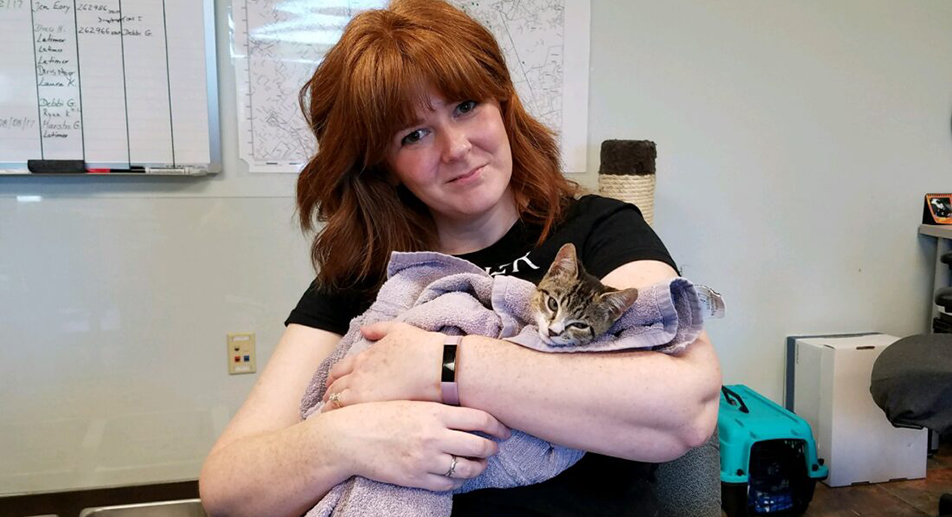
Tabby’s Place: A Cat Sanctuary was created in 1999. It’s a cage-free sanctuary that provides refuge and medical care to cats in desperate situations.
Tabby’s Place received a major gift to build a new wing dedicated to providing care for cats with leukemia. To complete the project, Tabby’’s Place needed to raise an additional $1.3MM.
Needing the knowledge and confidence to make big asks, the Tabby’s Place team partnered with Capital Campaign Pro. The organization worked with a talented campaign advisor, and was able to exceed its original goal, which means it can now fund critical renovations in addition to the construction of a new leukemia wing.
Want to explore our other examples of successful capital campaigns? Check out our Client Results page!

Capital Campaign Fundraising in Uncertain Times
Unexpected shifts in the market and social crises (like the COVID-19 pandemic) can unsettle even experienced fundraisers and board members. But remember that capital campaigns usually take three or even more to complete anyway. It’s important to understand that campaigns often span economic ups and downs — they’re designed to have some built-in flexibility for both the goal and the timetable.
When it comes to fundraising in difficult times, you may feel anxious about the future and worried that your donors will stop giving or give less than they might in more prosperous times. However, your job as a development professional is to stay calm and keep moving the campaign forward. We have two key pieces of advice:
Stay in touch with your donors
The more uncertain the times, the more closely you should stay in touch with your donors. In particular, uncertain times provide opportunities to reach out to your largest donors and ask their advice.
Donors will respond to financial uncertainties in different ways. Some will hunker down and reduce their giving. Others will step up because of the crisis at hand. But just about all of them will be willing — even happy — to tell you about how they are responding to the situation.
Use the uncertain times to build even stronger relationships with your donors by staying in touch with them, sharing the ways in which your organization is carrying out its mission, and finding out how the crisis is affecting them.
Continue raising money
While it may feel inappropriate during a crisis, don’t hesitate to ask donors for help. Some donors may be even more inclined to make a commitment to your campaign just to be sure that it doesn’t come to a halt. Those donors understand that your campaign is important and that the projects and programs it will fund will continue to be important long after the crisis has passed.
To see some examples, check out these success stories of our own clients who ran successful mini-capital campaigns during the worst of the pandemic.
Celebrate your donors’ generosity and sympathize when they have to trim their philanthropy for the time being. You and your donors are in this crisis together. The way in which you work with them will shape your organization’s future for years to come!
Get Your Campaign Questions Answered
Join our community for these monthly town-hall style discussions and get answers to your most burning questions in real time.

Capital Campaign Knowledge Directory
Before you dive headfirst into laying out your objectives or putting together a planning committee, we recommend you keep learning more. After all, capital campaigns are complicated. Here we’ve gathered our most helpful resources and exercises that you can use to learn more about different aspects of capital campaigns:
The Capital Campaign Model and Variations
- The Hidden Power of Capital Campaigns: The Trojan Horse Effect
- How to Set the Right Capital Campaign Goal Every Time
- Capital Campaign Capacity Building: New Use for the Campaign Model
- Add a Thimble-Sized Capital Campaign to Your Fundraising Toolbox
The Phases of a Capital Campaign
- Capital Campaign Timeline: 7 Steps to Lead a Successful Campaign
- Capital Campaign Plan: 11 Essential Elements & Top Tips
- Capital Campaign Feasibility Study: The Ultimate Guide
- Capital Campaign Quiet Phase: 3 Tips for a Successful Start
- Use the Public Phase of Your Campaign to Energize Your Community
- Post-Campaign Follow-Through: What You Must Do in the Final Phase
Your Capital Campaign Team
- Capital Campaign Consultant: The Ultimate Hiring Guide
- A Small But Mighty Campaign Team: 4 Indicators of Success
- Capital Campaign Volunteers: How to Select and Recruit Top Supporters
- Capital Campaign Committees: The Ultimate Guide
- How to Use Ad Hoc Capital Campaign Committees to Engage Key Donors
- Capital Campaign Resources, Tips, Tools, and FAQ for Board Members
- The Two Stages of Board Preparation for a Capital Campaign
Asking for Campaign Gifts
- Major Gift Fundraising: A Critical Component of Any Capital Campaign
- Overcome Your Fear of Asking for Leadership Capital Campaign Gifts
- 4 Easy Solicitation Training Exercises for Campaign Volunteers
- How to Ask for a Capital, Annual, and Planned Gift in One Meeting
Capital Campaign Resources and Support You’ll Need
- Capital Campaign Case for Support: Crafting a Complete Plan
- Creating a Capital Campaign Budget that Works: Quick Guide
- Capital Campaign Gift Range Chart: Understanding The Basics
Capital Campaigns and Risk
- 3 Simple Fundraising Risks for the Risk-Averse Fundraiser
- Capital Campaign Stalled Out? 3 Ways to Regain Momentum
- 10 Lessons Learned After Two Years Fundraising with COVID
- How to Recession-Proof Your Capital Campaign In Uncertain Times
If you’re considering a capital campaign, schedule a complimentary strategy session to discuss your campaign goals with one of our experts. We’ll help you plot a path forward and determine whether Capital Campaign Pro would be a good fit for your campaign.
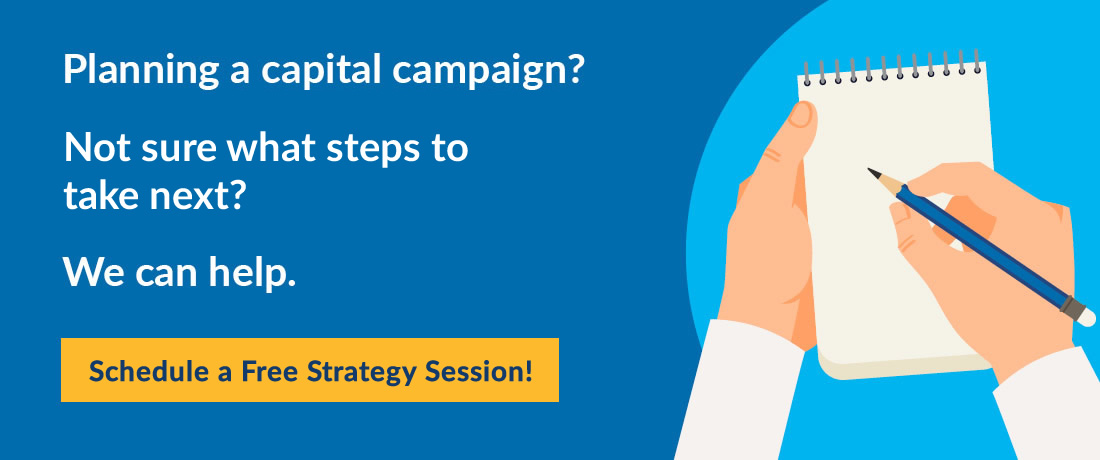



Leave a Comment